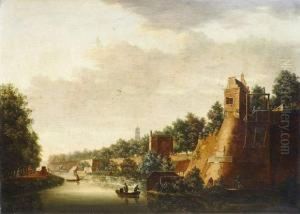Pieter Jacobsz. Van Liender Paintings
Pieter Jacobsz. Van Liender was a Dutch artist known for his landscape drawings and etchings. Born in 1689 in Haarlem, Netherlands, he was part of a family of artists and developed his skills under the influence of his environment and the Dutch tradition of landscape painting. His work is characterized by detailed depictions of rural and urban landscapes, often featuring waterways, which were a prominent feature in the Dutch landscape.
Van Liender's artistic career was shaped by the Dutch Golden Age's tail end, a period that had witnessed an explosion in the popularity of landscape art. Though he was born after the peak of the Golden Age, the demand for landscape imagery continued into the 18th century, and Van Liender's work reflects the ongoing interest in capturing the Dutch environment. His landscapes are noted for their precise detail and the delicate handling of light and shadow, which added a sense of depth and realism to his compositions.
Despite his talent, Pieter Jacobsz. Van Liender did not achieve the same level of fame as some of his contemporaries. However, his works were appreciated by collectors and connoisseurs of the time for their quality and craftsmanship. He was part of a family of artists; his brothers, Jan and Paulus van Liender, were also noted for their artistic endeavors, particularly in the realm of landscape art.
Pieter Jacobsz. Van Liender passed away in 1752, leaving behind a body of work that has since been studied and admired for its contribution to the Dutch landscape tradition. While not as widely known as other Dutch masters, his work provides valuable insights into the landscape genre's evolution and the artistic trends of his time.






